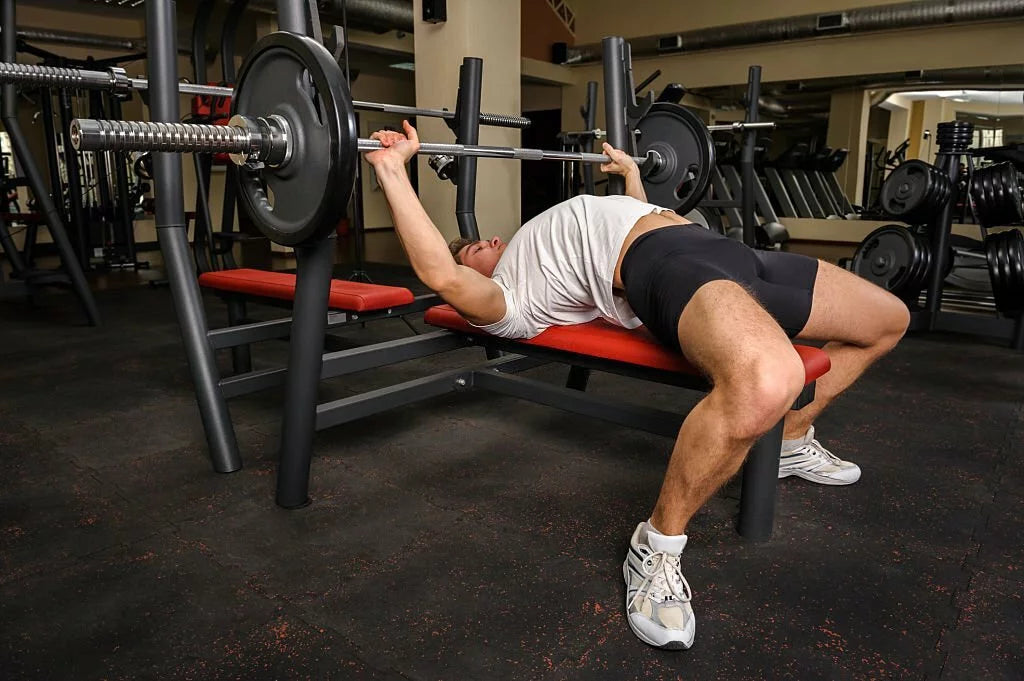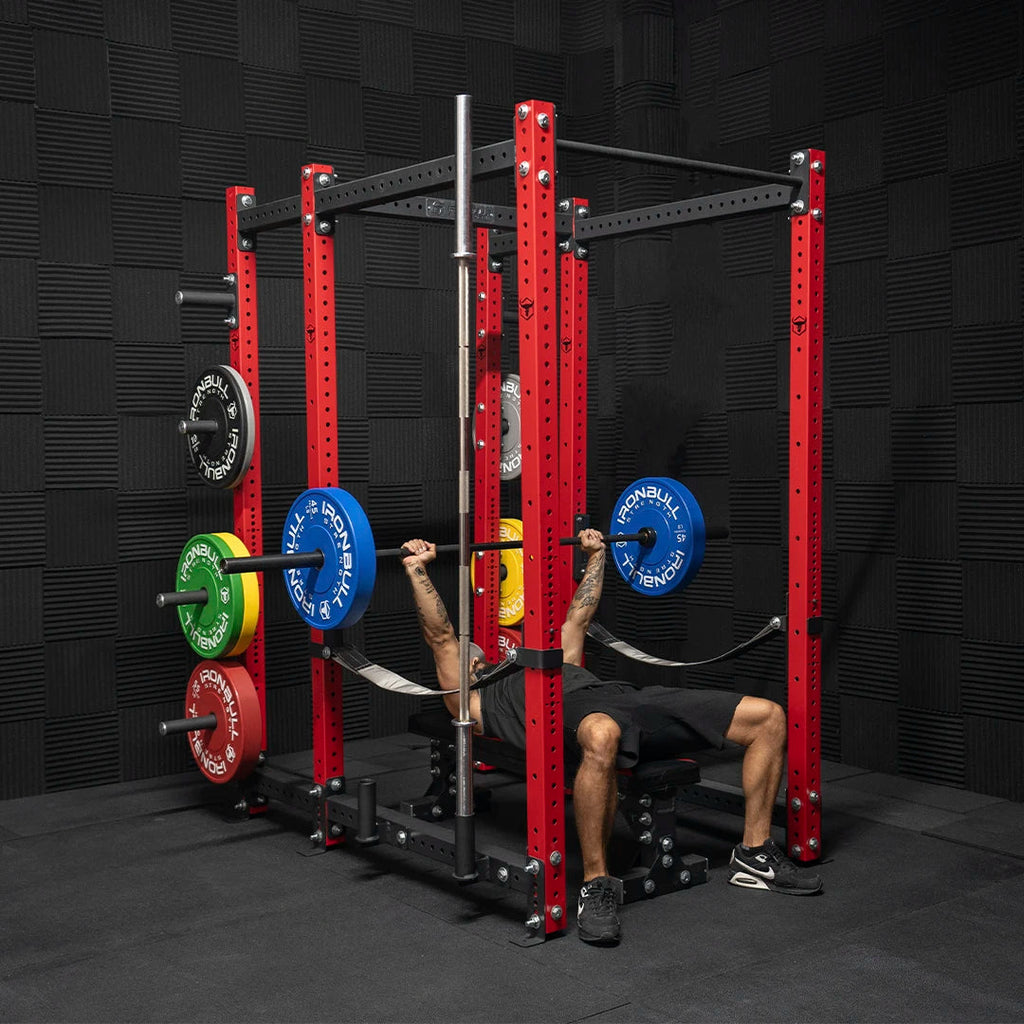Maximiser l'entraînement des jambes avec le développé couché


Pour réussir au développé couché, de nombreuses caractéristiques peuvent améliorer votre force maximale. L'une d'elles est la poussée des jambes. Qu'est-ce que la poussée des jambes au développé couché ? C'est utiliser la force de vos jambes de manière stratégique pendant le développé couché, en appuyant vos pieds au sol pour améliorer votre puissance et votre explosivité.
Utiliser la poussée des jambes au développé couché procure un avantage considérable à l'athlète. Cependant, malgré cet avantage, le concept peut être difficile à maîtriser, car il requiert coordination, pratique et connaissance de la poussée des jambes. C'est précisément l'objectif de cet article. Si vous manquez de soutien au développé couché, vous êtes au bon endroit !
Dans cet article, nous aborderons la définition de la poussée des jambes, la préparation adéquate, la technique, les avantages et comment bien s'entraîner avec la poussée des jambes. Après avoir lu cet article, vous devriez vous sentir prêt à commencer à utiliser la poussée des jambes au développé couché et à atteindre un niveau supérieur !
Comprendre la propulsion des jambes
Comme mentionné précédemment, la poussée des jambes au développé couché consiste à utiliser la force de vos jambes de manière stratégique, en appuyant vos pieds au sol pour améliorer la puissance et l'explosivité de votre pressing. C'est l'une des nombreuses façons d'améliorer la puissance au développé couché, et ce, pour de multiples raisons :
- Rend votre développé couché plus stable
- Maintient votre corps plus rigide et plus serré
- Vous donne plus de puissance au niveau de la poitrine
Rend votre développé couché plus stable
Pour utiliser la poussée des jambes, vous devez être en « position de puissance », ce qui nécessite de cambrer le haut du corps, en posant la tête, les épaules et les hanches sur le banc. En cambrer, les muscles du dos se contractent pour maintenir cette cambrure, ce qui améliore votre stabilité au développé couché. De plus, le fait d'être bien calé au sol favorise également la cambrure, ce qui vous assure une bonne stabilité au développé couché. Être en position de puissance, le dos cambré, les pieds à plat et, éventuellement, l'utilisation d'une ceinture de sécurité, constitue la combinaison idéale de stabilité pour un développé couché performant.
Maintient votre corps plus rigide et plus serré
Nous avons mentionné précédemment que la position de force au développé couché était essentielle à la stabilité. Cette position permet également de maintenir le corps fort et tendu pendant le développé couché. L'avantage d'une position plus serrée ou « rigide » au développé couché est d'améliorer le contrôle du développé couché, ce qui vous permet de vous sentir plus fort et de mieux mobiliser votre puissance musculaire pour un développé couché réussi. Il est également important d'envisager l'utilisation d'équipements de protection comme des bandages pour les poignets ou des coudières pour renforcer la rigidité de votre position au développé couché.
Vous donne plus de puissance au niveau de la poitrine
Isaac Newton, créateur des « lois du mouvement », intervient dans cette discussion. La troisième loi de Newton stipule que « pour chaque action, il existe une réaction égale et opposée ». Cela s'applique à la puissance du développé couché, due à la poussée des jambes et à la position de force de l'athlète. Lorsque l'athlète adopte une position plus stable et plus rigide grâce à la position de force, cette position plus forte contribue à mieux soutenir la puissance des pectoraux pendant le développé couché. Une fois la barre descendue et en contact avec la poitrine, l'athlète peut utiliser la poussée des jambes pour pousser au sol et obtenir plus de puissance et d'explosivité au niveau des pectoraux. Là encore, tout cela est dû à la stabilité et à la rigidité de la position de force, qui inclut la poussée des jambes, élément essentiel à la réussite de tout développé couché.
Configuration appropriée pour le développé couché avec entraînement des jambes
Pour obtenir une meilleure poussée des jambes au développé couché, vous devez suivre quelques étapes. La plus importante consiste à adopter la position de puissance. Dans cette position, les jambes sont plantées au sol afin d'augmenter la puissance délivrée et d'optimiser la performance du développé couché.
La configuration appropriée pour l'entraînement des jambes au développé couché est la suivante :
- Rétracter vos omoplates
- Installation de votre arche
- Planter vos pieds à plat sur le sol
- Mettre du poids sur vos pieds
Rétracter vos omoplates
Rétracter les omoplates est essentiel pour maximiser la poussée des jambes au développé couché. Commencez par vous allonger sur le banc et, avant de retirer la barre, concentrez-vous sur le rapprochement des omoplates et leur abaissement vers les hanches. Ce mouvement crée une position stable et ferme du haut du dos. Une bonne assise dorsale vous permet de maintenir une cambrure correcte et un transfert de puissance optimal entre les jambes pendant le mouvement.
Installation de votre arche
Une cambrure du bas du dos est essentielle pour un développé couché efficace et pour améliorer la poussée des jambes. Tout en contractant le haut du dos, cambrez légèrement le bas du dos en poussant la poitrine vers la barre. Cette cambrure vous permet de maintenir une position plus avantageuse pour la poussée des jambes et de réduire l'amplitude de mouvement.
Planter vos pieds à plat sur le sol
Vos pieds doivent être à plat sur le sol, vos genoux formant un angle proche ou supérieur à 90 degrés. Cela offre une base solide et permet une poussée efficace des jambes. Vos pieds doivent être placés sous vos genoux ou légèrement en arrière, pour une base stable. Cette position permet également d'éviter que vos hanches ne se décollent du banc, ce qui est essentiel pour un soulevé légal en compétition de dynamophilie.
Mettre du poids sur vos pieds
Une fois vos pieds en position correcte, poussez activement sur vos talons et mettez du poids sur vos pieds. L'objectif n'est pas de décoller vos hanches du banc, mais de solliciter les muscles de vos jambes et de créer une tension. Cette poussée des jambes génère une puissance supplémentaire pour faciliter la phase ascendante du développé couché. Vous devriez sentir vos jambes, vos fessiers et le bas de votre dos travailler ensemble pour fournir cette poussée.
.
Technique d'utilisation de la poussée des jambes
La meilleure façon d'adopter la bonne technique pour une meilleure poussée des jambes dépend principalement de votre configuration. En suivant nos conseils pour la configuration de votre développé couché, vous obtiendrez une technique parfaite pour réaliser un développé couché lourd en salle.
Pour le développé couché, positionnez-vous en position de force. En position de force, vos pieds sont à plat au sol pour une forte poussée des jambes. L'objectif est qu'une fois la barre descendue sur votre poitrine, vos pieds s'appuient sur le sol et fournissent la puissance de la poussée des jambes qui mène au développé couché.
Avec les pieds à plat au sol, votre torse est bien mieux contrôlé et préparé à supporter des charges plus lourdes. C'est un bénéfice immédiat de l'intégration de la poussée des jambes. Lorsque la barre commence à descendre sur votre poitrine, l'anticipation de la poussée des jambes incite également votre développé couché à être beaucoup plus dynamique que d'habitude. La poussée des jambes transmet la puissance des pieds jusqu'aux mains, mais c'est la combinaison de nombreux autres facteurs du développé couché qui rend cette technique si spéciale.
Avantages de l'intégration de la poussée des jambes dans le développé couché
De nombreux avantages de l'intégration de la poussée des jambes ont été décrits dans cet article. La poussée des jambes contribue à la stabilité, à la rigidité et au contrôle du développé couché, améliorant ainsi vos capacités. Une autre idée que nous n'avons pas encore eu l'occasion de présenter officiellement est l'activation musculaire rapide.
Lorsqu'on utilise la poussée des jambes, l'objectif n'est pas seulement d'être fort, mais aussi rapide ! On pourrait aussi parler d'explosivité ou de puissance. Ainsi, lorsque la poussée des jambes est intégrée au développé couché, cela signifie que nous souhaitons être beaucoup plus explosifs et dynamiques dans notre intention.
La poussée des jambes nous permet de travailler l'explosivité du développé couché. Si vous observez certains des meilleurs développés couchés au monde, comme Julius Maddox et TD Smash, vous remarquerez que lorsqu'ils appuient sur leur poitrine, ils enfoncent leurs pieds au sol et, avec une poussée explosive, la barre de leur poitrine peut être propulsée en orbite. Vous ne deviendrez jamais un meilleur développé couché en vous contentant de développer votre force ; il faut aussi de la vitesse et de la rapidité dans vos répétitions.
Répondre aux préoccupations concernant la propulsion des jambes
Certains pensent que la poussée des jambes est une tricherie. Cela concerne principalement la position de puissance. De nombreux haltérophiles se mettent en position de puissance, cambrent le dos autant que possible, et il semble que la barre se déplace avec une trajectoire très minimale. Cela pourrait être dû à une mobilité accrue ou à des proportions optimales auxquelles vous êtes génétiquement prédisposé. Quoi qu'il en soit, rien n'excuse vos performances médiocres ; vous devez améliorer votre développé couché en fonction de ce que vous maîtrisez !
Lors de l'entraînement des jambes, il arrive que les athlètes soulèvent leurs hanches du banc afin d'adopter une position mécaniquement plus avantageuse et plus forte que si l'on restait en contact avec le banc. Dans ce cas, il s'agit d'une caractéristique très mal vue du développé couché. Pour y remédier, il est important d'ouvrir sa position afin de limiter la capacité de ses hanches à se soulever du banc et à effectuer des répétitions incorrectes. De cette façon, vous pouvez intégrer l'entraînement des jambes sans sollicitation excessive des hanches, ce qui pourrait être problématique, surtout lors d'une compétition officielle de powerlifting.
Variations du développé couché avec entraînement des jambes
Lors d'un entraînement axé sur la performance, il est important d'inclure des variations de mouvements pour améliorer vos capacités. Dans ce cas, il peut être judicieux de pratiquer des variantes du développé couché sans poussée des jambes, comme le développé couché au sol ou le développé Larsen. Ces deux mouvements vous apprendront à être explosif avec uniquement le haut du corps. Vous comprendrez ainsi l'importance de la poussée des jambes pour vos performances et son impact positif sur vos capacités.
Le développé couché est un exercice de musculation classique qui consiste à s'allonger au sol et à appuyer uniquement avec le haut du corps. En limitant l'effort des jambes, il vous oblige à solliciter uniquement les muscles du haut du corps, ce qui favorise une force et une puissance accrues. Cet exercice est particulièrement utile pour identifier et corriger les faiblesses de vos mouvements de développé couché, notamment lors du lock-out, car l'amplitude de mouvement est limitée puisque vos coudes toucheront le sol avant que la barre ne touche votre poitrine.
Le développé Larsen est une autre technique efficace qui privilégie le développement de la force du haut du corps en réduisant la poussée des jambes. Cet exercice nécessite de décoller les jambes du sol, ce qui permet d'effectuer le développé couché sans poussée des jambes et avec une amplitude de mouvement complète. Cet exercice sollicite davantage les muscles du haut du corps, ce qui en fait un choix idéal pour ceux qui cherchent à développer leur force au développé couché. En intégrant le développé au sol et le développé Larsen à votre routine, vous pourrez améliorer la force du haut du corps sans poussée des jambes et profiter de tous ses bienfaits.
Conseils d'entraînement pour optimiser la poussée des jambes
Pour améliorer la motricité de vos jambes, vous devrez intégrer des exercices du bas du corps qui sollicitent spécifiquement les articulations du genou et de la hanche. Il est judicieux de réaliser des exercices composés pour les jambes, mais il est également judicieux de réaliser des exercices d'isolation, séparément pour les articulations du genou et de la hanche, afin de solliciter ces muscles au maximum.
Parmi les exercices qui pourraient vous aider à améliorer votre force de jambes, on peut citer le squat, la presse à cuisses , l'extension des jambes et les poussées de hanches. Le squat est un excellent exercice composé qui sollicite à la fois les articulations du genou et de la hanche. Cependant, si vous craignez pour la récupération de vos pectoraux ou si vous avez des limitations au niveau des épaules, vous pouvez également utiliser la presse à cuisses, qui sollicite également les articulations du genou et de la hanche. Nombre des meilleurs athlètes de développé couché au monde essaient d'éliminer les squats avec haltères de leur routine afin de ne pas étirer leurs pectoraux et de ne pas perdre la rigidité de ce muscle principal pour un développé couché intensif.
Les extensions de jambes et les poussées de hanches sont d'excellents exercices d'isolation qui ciblent l'articulation du genou ou de la hanche pour maximiser le développement de la force. Les mouvements composés sont très efficaces pour travailler plusieurs groupes musculaires simultanément. Cependant, les exercices d'isolation sollicitent au maximum des groupes musculaires isolés afin de garantir leur bon développement et d'améliorer le développement de la force et de la puissance.
Conclusion
La poussée des jambes au développé couché peut être un atout majeur pour quiconque souhaite améliorer sa force et ses performances du haut du corps. Dans cet article, nous avons abordé la définition de la poussée des jambes, les techniques de préparation adéquates et les nombreux avantages qu'elle peut apporter pour améliorer son développé couché. La poussée des jambes dépend essentiellement de votre préparation, appelée « position de puissance ». Avec une position de puissance plus forte, le corps est plus stable, plus rigide et mieux préparé à la poussée des jambes, pour un développé couché beaucoup plus puissant.
Il ne s'agit pas seulement de comprendre l'importance de la poussée des jambes, mais aussi de savoir comment l'intégrer efficacement. En position de puissance, vos pieds sont à plat et plantés au sol pour une surface d'appui plus solide et une meilleure impulsion pour stimuler la puissance de votre poitrine. Que vous soyez un powerlifter de compétition ou que vous cherchiez simplement à atteindre de nouveaux sommets dans votre entraînement, comprendre et mettre en pratique la poussée des jambes peut être une étape cruciale vers l'atteinte de vos objectifs.


